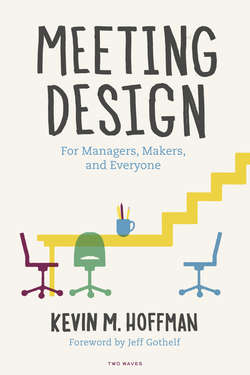Читать книгу Meeting Design - Kevin M. Hoffman - Страница 7
На сайте Литреса книга снята с продажи.
Foreword
ОглавлениеWhen I was commuting regularly to New York City for work, I’d look at my calendar on the train ride in and see what meetings lay ahead. Based on how productive I felt each one was going to be, I’d plan out how to pass the time in the meeting. For most, I figured I could knock out some email on my phone under the table. For a couple, I could probably get away with answering some questions from my team in chat. For one, two max, I knew I’d have to pay attention and participate and, in all likelihood, show up prepared.
Why? What was the difference between these meetings where I knew I could tune out versus the ones where I’d have to lean in?
Let’s face it—most of my meetings were awful. They were hastily called, poorly planned, and involved far too many people to yield any kind of traction. So what’s the solution? It seems to be more meetings. When you add in every company’s adoption of Agile rituals—stand-ups, iteration planning meetings, and retrospectives—and multiply that times the number of projects each person supports, it becomes a miracle that anything actually ever gets done at work.
And yet, to do our best work, collaboration is required. It’s a successful company’s secret weapon. We need to meet with our colleagues, hear their opinions, debate options, and make clear the decisions on the next steps.
But how many meetings have you attended recently that actually yielded concrete next steps and felt like a good use of your time? If you’re like most people, the answer is probably pretty low. Creating great meetings is a people problem. It requires empathy for the participants, as well as a clear sense of their goals and the decision-making framework for not only deciding how to structure the meeting but whether one should happen at all.
In the software world, we advocate for changing our mindset from one focused on outputs—delivering features—to one motivated to drive outcomes—meaningful and measurable changes in customer behaviors. This mindset reshapes our definition of “done.” The same model can be applied to meetings. In some organizations, the measure of success for some people is how many meetings they attend (i.e., output). The goal is, seemingly, to spend as much time in meetings to showcase the individual’s productivity, importance, and contributions. How do we know that this contribution yielded anything positive to the cause we’re pursuing? Just because the meetings took place doesn’t mean that we had an impact of any kind on the success of our team, project, or company.
Instead, how can we figure out what outcomes our colleagues are trying to achieve by attending this meeting? Our job should be to design solutions that help them reach those outcomes. Sometimes that will be a meeting. In other cases, it might be some other activity or no activity at all.
In Meeting Design, Kevin lays out exactly how to take on meetings as a design problem, but you don’t have to be a designer to appreciate this advice. He deftly illustrates how the designer’s toolkit—a collection of questions, activities, and conversations—can be applied to create the best outcomes for these age-old activities.
Kevin applies design thinking in tactical ways to teach you how to learn what your colleagues truly need. His approach lays out tactic after tactic for structuring agendas, ensuring broad, active participation, and guaranteeing that no one leaves another meeting again feeling that time was wasted. Perhaps most importantly, he provides a clear way to assess whether a meeting is actually required and how to push back to sharpen its focus or cancel it altogether.
I’ve had the pleasure of spending time with Kevin personally and professionally. I’ve always been impressed by his balance of detailed research, pragmatism, and sense of humor, which all translate to a remarkably well-thought-out and useful book.
—Jeff Gothelf, designer, Agile practitioner, and author of Sense and Respond: How Successful Organizations Listen to Customers and Create New Products Continuously and Lean UX: Designing Great Products with Agile Teams
